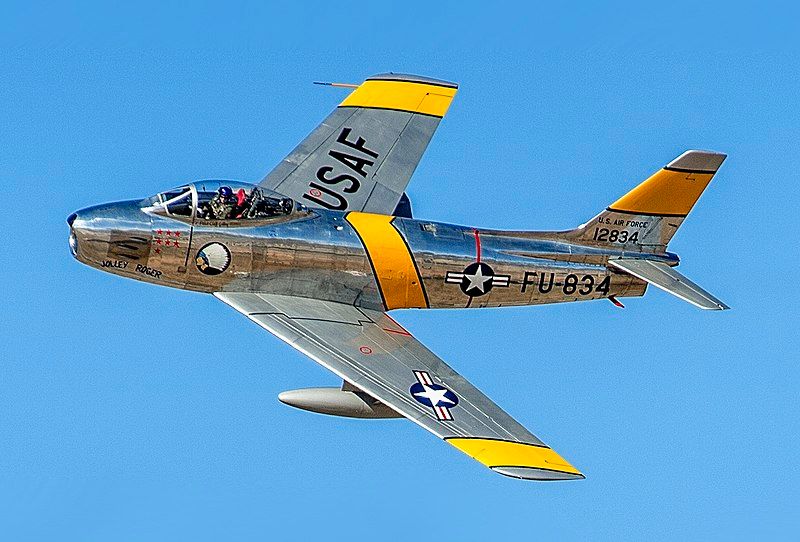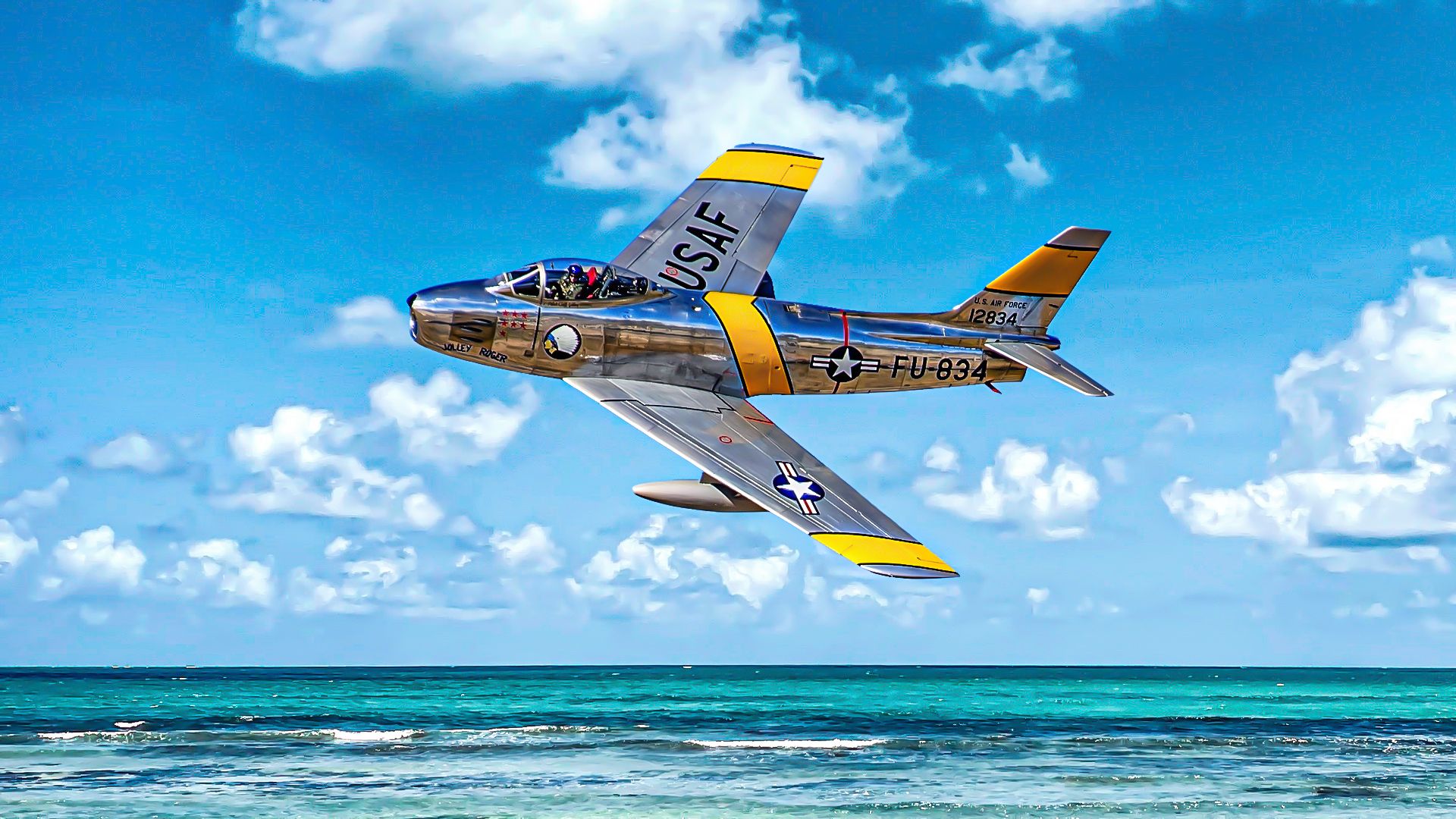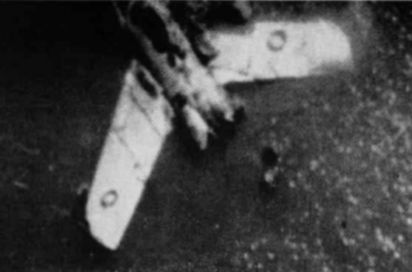Summary
- The F-86 Sabre jet fighter was developed quickly in response to the MiG-15 threat during the Korean War.
- The F-86 had a 5.6 to 1 kill ratio against the MiG-15, showcasing its combat effectiveness.
- Many F-86 pilots were WWII veterans whose experience contributed to their success in jet dogfights.
When I think of the F-86 Sabre jet fighter, two proverbs come to mind for me:
- “Necessity is the mother of invention.”
- “Desperate times call for desperate measures.”
Both of those truisms were applicable in spades to the F-86. As I wrote in an article titled “Pictures: 5 Best Fighter Jets Of All Time”, which was published in 19FortyFive back in May 2023:
“[A]fter being initially taken by surprise by the Soviet-designed MiG-15s that ravaged the USAF’s F-80 Shooting Stars and F-84 Thunderjets [in retrospect, I could have just as easily added the Grumman F9F Panther to that list], U.S. R&D designed and deployed the F-86 in record time.”
So then, how exactly did the F-86 become the game changer of the deadly air war in the skies over the Korean Peninsula? Simple Flying now takes a look.
 F-86 initial history and specifications
F-86 initial history and specifications
The North American F-86 Sabre took its maiden flight on October 1, 1947, and entered operational service with the US Air Force in 1949. In other words, the Sabre jet was designed and adopted before the Korean War started. However, the arrival of the MiG-15 (NATO reporting name: “Fagot”) on-scene during the conflict certainly kicked into overdrive the USAF’s sense of urgency to get the ’86s built and deployed en masse.
The MiG-15’s NATO reporting name is not intended as a slur. Dictionary.com defines “fagot” (one “g,” not two) as “a bundle of sticks, twigs, or branches bound together and used as fuel, a fascine, a torch, etc.”
Sabre specifications included:
|
Fuselage Length: |
37 ft 1 in (11.30 m) |
|
Wingspan: |
39 ft 1 in (11.91 m) |
|
Height: |
14 ft 1 in (4.29 m) |
|
Empty Weight: |
11,125 lb (5,046 kg) |
|
Max Takeoff Weight: |
18,152 lb (8,234 kg) |
|
Powerplant: |
1 × General Electric (GE) J47-GE-27 turbojet engine, 5,910 lbf (26.3 kN) thrust |
|
Max Airspeed: |
|
|
Combat Range: |
414 mi (666 km, 360 NM) with two 1,000 lb (454 kg) bombs and 2x 200 US gallons (170 imp gal; 760 L) drop tanks |
|
Service Ceiling: |
49,600 ft (15,100 m) at combat weight |
|
Rate of Climb: |
9,000 ft/min (46 m/s) at sea level |
|
Armament: |
|
“Don’t give me an ’86-D
She’s fast, I don’t care
Give Me Operations as sung by Dick Jonas (Lt. Col., USAF [Ret.])
Operational (Korean War combat) performance
How exactly did the Sabre jet stack up against the MiG-15? As I explained in my 19FortyFive piece:
“The Sabre jet couldn’t fly as high, climb as fast or maneuver as agilely as its Communist-made opponent, but it could dive faster, was more aerodynamically stable, and had a radar gunsight that came in handy during high-speed jet dogfights…Admittedly, the long-accepted 10:1 kill ratio of the F-86 has had doubt cast upon it in more recent years…But even when those raised figures as[sic] factored in, that still leaves us with 566 MiG-15s were destroyed by Sabres vs. roughly 100 F-86s shot down, which would put the U.S. kill ratio at about 5.6 to 1.”
Which is still a highly respectable kill ratio by any measure. The consensus seems to be that the MiG-15 was heavily outperformed by the F-86 when the former was flown by North Korean or Red Chinese pilots, but the dogfights were more evenly matched when the MiG-15s were flown by Soviet pilots (one of the worst-kept secrets of the Korean War).
One advantage of the MiG-15 I’d neglected to mention was that it also had the more powerful guns of the two contenders:
- 2 × 23 mm (0.90 in) Nudelman-Rikhter NR-23 autocannon in the lower left fuselage (80 rounds per gun, 160 rounds total)
- 1 × 37 mm (1.45 in) Nudelman N-37 autocannon in the lower right fuselage (40 rounds total)
However, the Soviet warbirds’ bigger guns weren’t as accurate or as fast-firing as the F-86’s .50 cals, and as many American jet pilots are fond of saying, “Speed is life”.
A key factor that helped the Sabre drivers overcome the MiG-15’s on-paper advantages was the experience factor; many of these USAF pilots were battle-hardened veterans of the Second World War whose skills flying piston-engined prop-driven fighters (the P-51D Mustang, P-47 Thunderbolt, P-38 Lightning, P-40 Warhawk, etc.) easily carried over to jet fighters.
The best example was Col. Francis Stanley “Gabby” Gabreski (January 28, 1919 – January 31, 2002), who was America’s highest-scoring air ace in the European Theatre of WWII, with 28 kills (all scored in the “T-Bolt”). During the Korean War, “Gabby” would score an additional six kills whilst at the controls of an F-86, thus becoming one of only seven American pilots to be an ace in two wars!
Where are they now?
Out of 9,860 F-86s built, roughly 22 airworthy specimens survive today, spread out between Australia (two), France (one), South Africa (one), and the United States (eighteen). Among the specific examples are:
As for static display Sabre jets, there are well over 100 airframes in the US alone. I can personally vouch for Serial No. 52-4689, an F-86A displayed alongside a MiG-15 (appropriately enough) at the National Air and Space Museum’s Steven F. Udvar-Hazy Center in Chantilly, Virginia.


